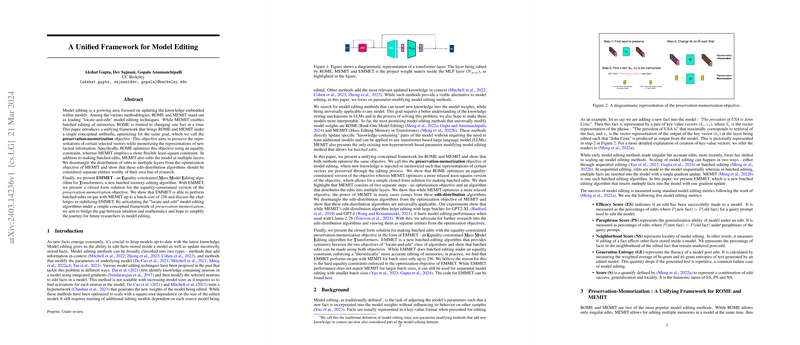Unveiling EMMET: Equality-Constrained Mass Model Editing in Transformers
Introduction
The landscape of model editing, a critical area in ensuring that machine learning models remain up-to-date with evolving data and facts, has seen considerable advancements with the advent of methods like ROME (Rank-One Model Editing) and MEMIT (Mass Editing Memory in Transformers). Model editing delineates from the traditional practice of retraining by specifically altering the parameters of a model to incorporate new or correct existing information without comprehensive retraining. This paper explores the conceptual unification of ROME and MEMIT under the preservation-memorization objective and introduces a novel approach, EMMET (Equality-constrained Mass Model Editing in Transformers), for batch editing within this unified framework.
Preservation-Memorization Objective: A Unifying Concept
At the heart of both ROME and MEMIT is the preservation-memorization objective, which seeks to maintain the response of a model to a subset of inputs while updating its knowledge base with new information. This objective encapsulates the dual requirements of model editing: altering the model's parameters to reflect new facts without deteriorating its performance on unchanged data.
- ROME implements this by optimizing for preservation using existing representations and enforcing the memorization of new facts with equality constraints.
- MEMIT, on the other hand, achieves a similar goal through a relaxed least-square constraint for memorization, which also facilitates the efficient incorporation of multiple new facts simultaneously.
Unveiling EMMET: A New Paradigm in Batch Editing
The introduction of EMMET represents a critical leap forward in model editing. By providing a closed-form solution for the equality-constrained version of the preservation-memorization objective, EMMET enables the batch editing of facts under equality constraints, a significant enhancement over ROME's singular editing capability.
- EMMET demonstrates comparable performance to MEMIT for batch sizes up to 256, affirming the viability of equality constraints in batch editing scenarios.
- However, challenges in stabilizing edits for larger batch sizes highlight the inherent limitations of strict equality constraints in managing multiple simultaneous edits, suggesting areas for future exploration and refinement.
Disentangling Edit-Distribution Algorithms
The paper makes a methodological distinction between the optimization objectives of model editing and the algorithms used to distribute edits across multiple layers of a model. This distinction sheds light on the adaptability and application scope of these algorithms beyond their original implementations.
- The experiments reveal that while edit-distribution algorithms enhance the efficacy of MEMIT in large-scale editing engagements, they may not universally benefit all models, as evidenced by their counterproductive impact on Llama-2-7B editing.
- These findings advocate for a more nuanced approach to the application of edit-distribution algorithms, tailored to the specific characteristics and requirements of the model being edited.
Theoretical Implications and Future Directions
The conceptual framework and the introduction of EMMET enrich the theoretical underpinnings of model editing by broadening the understanding of the preservation-memorization objective and demonstrating the feasibility of batch editing under equality constraints.
- The differentiation between optimization objectives and edit-distribution algorithms invites a reevaluation of existing editing strategies and encourages the development of more flexible and model-specific approaches.
- The performance of EMMET, particularly in scenarios with smaller batch sizes, offers a promising avenue for sequential model editing and underscores the potential for further advancements in this domain.
Conclusion
This paper contributes significantly to the model editing field by unifying ROME and MEMIT under a common conceptual framework, introducing EMMET for equality-constrained batch editing, and calling attention to the distinct role of edit-distribution algorithms. The insights gleaned from these developments not only pave the way for more nuanced and effective model editing strategies but also highlight the dynamic interplay between theoretical principles and practical applications in the ongoing evolution of machine learning technology.
